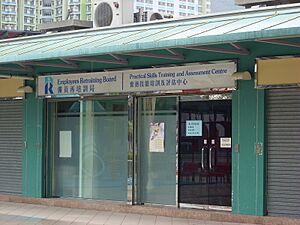Assessment centre facts for kids
An assessment centre is a special process used to find out if someone is a good match for a job, especially for important roles like managers or military officers. It's not just a building, but a series of activities. During this process, experts look at a person's skills and how they act. They use different methods like interviews, group activities, presentations, and tests to see what someone is good at.
Contents
How Assessment Centres Started
Ancient Times: Gideon's Test
One of the earliest examples of assessing people comes from an old story about a leader named Gideon. He needed to pick the best warriors for his army.
Then the Lord said to Gideon, “The people are still too many; bring them down to the water and I will test them for you there. Therefore it shall be that he of whom I say to you, ‘This one shall go with you,’ he shall go with you; but everyone of whom I say to you, ‘This one shall not go with you,’ he shall not go.” So he brought the people down to the water. And the Lord said to Gideon, “You shall separate everyone who laps the water with his tongue as a dog laps, as well as everyone who kneels to drink.” Now the number of those who lapped, putting their hand to their mouth, was 300 men; but all the rest of the people kneeled to drink water. The Lord said to Gideon, "I will deliver you with the 300 men who lapped and will give the Midianites into your hands; so let all the other people go, each man to his home."
—Judges 7:4–7
Gideon watched how his soldiers drank water. Only 300 men scooped water with their hands, staying alert. He chose these 300, showing an early way of assessing who was best for a task.
Modern Beginnings: Military Use
In the 1930s, the German army started using assessment methods to pick its officers. A psychologist named Max Simoneit led this effort, creating tests to find good leaders. During World War II, assessment centres became very important. They were used to choose officers for the military. Even today, armies around the world, like the Royal Navy and the British Army, use these methods to find new officers.
Assessment Centres in Business
After World War II, companies started to see the value of assessment centres. In the 1950s, a company called AT&T in the United States began using them. Douglas W. Bray, a human resources director, led a long study that showed assessment centres could predict how well young managers would do in their careers. This success led many other big companies, like IBM and Standard Oil, to start using assessment centres too.
Rules and Guidelines
In 1975, the first rules for using assessment centres were made. These rules help make sure the process is fair and accurate. They cover things like how to run the assessments, how to make sure the information is correct, and what skills the people running the assessments need. These rules have been updated over the years to keep up with new laws and technology. The latest version was approved in 2014. Today, organizations all over the world use assessment centres to help them choose new employees and find ways to help their current staff grow.
Why Use Assessment Centres?
An assessment centre is a way to gather important information about what a person can do. It helps organizations understand if someone has the right skills and behaviors for a specific job.
What Happens at an Assessment Centre?
During an assessment, candidates take part in different activities. These activities are designed to be like real-life situations they would face in the job. For example, they might do:
- Job simulations: Acting out parts of the job to see how they handle tasks.
- Interviews: Talking with assessors about their experiences and skills.
- Group exercises: Working with other candidates on a task to see how they teamwork and lead.
- Presentations: Giving a speech on a topic to show their communication skills.
- Tests: Taking written tests to check their knowledge or problem-solving abilities.
By watching how candidates perform in these activities, assessors can see if they have the necessary skills and behaviors for the job. This helps them make good decisions about who to hire, especially for important roles like police chiefs or fire captains. The main goal of an assessment centre is to get a full picture of a person's skills and how they think, to help predict how well they will do in a job.


